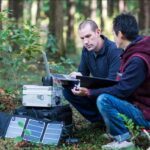通过移动和 PDA 智能手机,可以使用全球定位系统跟踪来定位找人。GPS 跟踪主要由父母用来跟踪孩子或老人。不过,GPS 跟踪设备传输的信息并不完全准确,位置信息可能会延迟或误解,具体取决于传输信息的最近卫星或蜂窝塔的位置。
全球定位系统定位器
1. 确保被定位的人拥有支持 GPS 的手机
手机必须打开,GPS 才能接收到信号。GPS 工作原理,是计算一个物体与距离它最近的三个天线的距离。
2. 连接到无线网络
GPS 跟踪服务由手机运营商提供,将支持 GPS 的移动设备配置到网络,以便在互联网上或通过网络塔发送数据。
3. 通过移动提供商选择基于位置的服务
这种方法是通过 Internet 网站或呼叫中心访问位置信息。LBS 提供商能够通过 GPS 发出的信号,给出一个人最后已知的大致位置。地图位置、转弯指示和短信提醒功能也是一些 LBS 提供商提供的服务。
4. 在购买计划之前比较 LBS 提供商
手机运营商也可以充当 LBS 提供商。在处理技术方面,不要总是选择价格便宜的。使用 GPS 进行人员跟踪有很多成本,包括允GPS 技术的设备成本、将手机连接到网络的设置、激活费用,以及能够访问特定手机上的位置信息的网络费用。生成的每个位置报告可能会产生费用,或者选择每月生成一定数量的报告。
5. 避免法律后果
在使用系统之前,订户必须获得使用 GPS 跟踪技术跟踪某人的许可。GPS 跟踪服务最常用的用途,是在紧急情况下,寻找 8-14 岁学龄儿童、以及年迈父母的位置。







